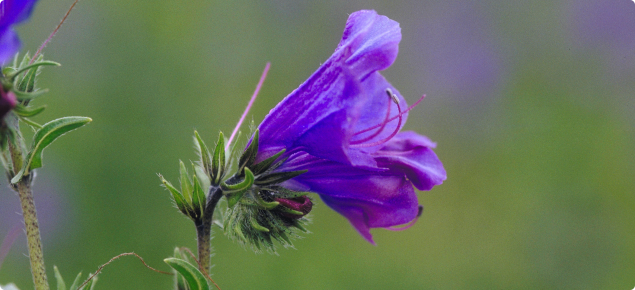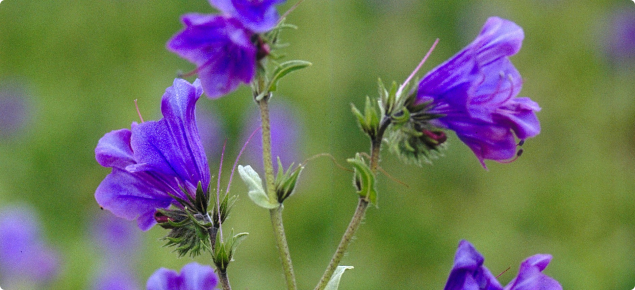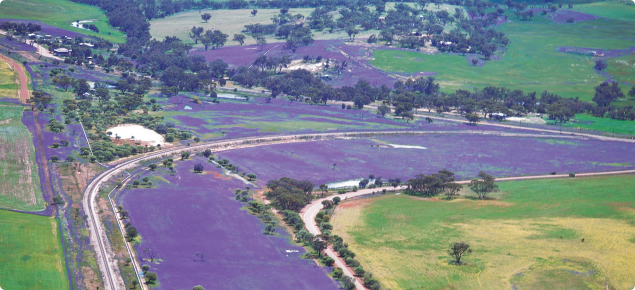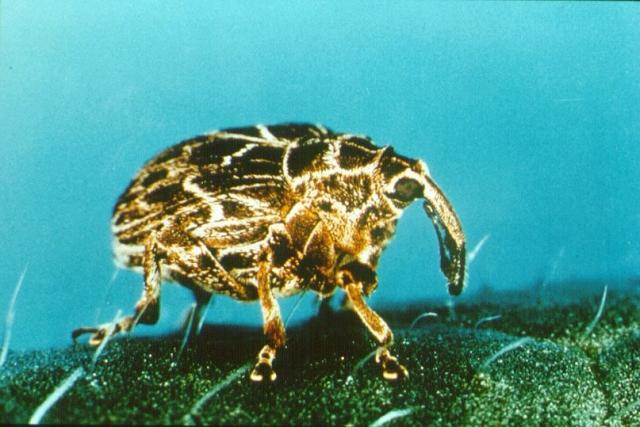What you should know about Paterson’s curse
Paterson’s curse (Echium plantagineum) is in the borage family, Boraginaceae, which includes some useful herbs and garden plants, and other toxic weeds such as yellow burr weed (Amsinckia spp.), viper’s bugloss (E. vulgare) and common heliotrope (Heliotropium europaeum).
With its purple flowers, Paterson’s curse is one of the most conspicuous weeds of pastures, roadsides and disturbed land in Western Australia. It is supposedly named after the Paterson family of Cumberoona, New South Wales, who planted it in their garden in the 1880s. In other parts of Australia it is sometimes called salvation Jane, blueweed, Lady Campbell weed or the Riverina bluebell. Paterson’s curse is a declared plant (noxious weed) and is a target for biological control.
Paterson’s curse is an annual plant native to the Mediterranean region. It is a classic ‘garden thug’ having been introduced via mail order gardening catalogues in the 1840s, then rapidly invading agricultural land.
Why Paterson’s curse matters
Paterson’s curse now covers millions of hectares of land in southern Australia (from WA to northern New South Wales) and is estimated to cost Australian sheep and cattle producers $250 million annually through lost productivity in pastures, control costs, and wool contamination.
It is highly competitive in pastures, replacing desirable plants without contributing to forage value. Paterson’s curse contains pyrrolizidine alkaloids, which are toxic to livestock, particularly horses, though sheep can graze it for a time. Prolonged grazing of Paterson’s curse is harmful, even to sheep, because the alkaloids eventually cause liver damage, especially if stock consume large amounts of this weed in winter and spring and then graze on common heliotrope over summer.
What you should look for
Paterson’s curse usually germinates in early autumn. Uncrowded plants develop into broad rosettes over the winter months. In dense infestations where plants are crowded, the leaves grow upright. Rosette leaves grow from 10-35cm long and are oval to elongated with distinct lateral veins. The rosettes may be confused with plantain (Plantago sp.), which are similar.
In spring, the plant produces one or many erect branched stems from 20-200cm tall. Stem leaves are narrow and smaller than the rosette leaves.
The whole plant is covered with tiny stiff bristles that may cause skin irritation when handled.
The 2-3cm long flowers are mostly purple but occasionally pink or white, and shaped like a curved trumpet.
Life history of Paterson’s curse
Paterson’s curse is a bristly, annual plant that usually germinates in early autumn and flowers in spring but it can germinate at any time of year if conditions are favourable. For example, it can germinate with heavy summer rain and produce small plants that flower and set seed in autumn. The seedlings quickly develop a strong root system and are quite drought resistant. It is found from north of Geraldton to the south coast.
Around Perth and Northam it prefers heavier soils and is common in the Swan and Avon Valleys, but it is found on sandy soils in the northern agricultural region.
Each flower produces four rough, grey or brown wrinkled seeds. Three are shed, but one is usually retained in the bristly calyx, which readily attaches to a passing animal. Flowering and seed production continues until November in most parts of the south-west, but may continue into summer in well-watered sites. Each plant can produce many seeds, which remain viable for up to six years. Dense stands eventually form a seed bank of up to 30 000 seeds/m².
Biological control
Biological control aims to limit the dominance of Paterson's curse to make it economically insignificant to farmers. Biological control is not an eradication program. It can take many years for the insects to reach their full potential and spread. Biological control requires more than one agent. For Paterson' curse there is a suite of four insects that have been released. Each insect attacks a different life stage of the plant. In some areas, these insects have caused a significant reduction in Paterson seed production.
Root weevil (Mogulones geographicus)
Description
Adults are 4-5 mm long, predominantly brown in colour in colour with a prominent curved snout. Larvae are 10-12 mm long, creamy white in colour and bore into roots.
Life cycle
The root weevil has a single generation each year. After heavy rains stimulate Paterson's curse germination, adult weevils become active, anytime between March to June. After feeding on rosette leaves for a week, female weevils become sexually mature and lay eggs into the leaf stalk of the rosette. Female weevils can lay eggs from March until October, with a single female laying on average 250 eggs.
Weevil larvae hatch and feed within the leaf stalk mining directly to the tap root where they are protected from grazing. In the taproot, 20-30 larvae can kill a rosette that is 15-20 cm in diameter. After feeding, larvae leave the tap root to pupate in the soil. Adult weevils emerge in spring and feed on the leaves and flowers of Paterson's curse. Adult weevils will also disperse to find new patches of Paterson's curse.
When Paterson's curse dies off, the adults move into the soil and leaf litter and become dormant to escape the summer heat. The adult weevils remain dormant until autumn rains stimulate them to become active and start a new generation.
Suitable areas
The ability of the root weevil to lay dormant in soil until May has allowed it to survive in areas where late breaks occur. As larvae survive in the taproot, this weevil can withstand grazing pressures on Paterson's curse.
Crown weevil (Mogulones larvatus)
Description
Adults are 3.5-4 mm long, black and white with a prominant curved snout. Larvae are 10-12 mm long, creamy white in colour and bore into the crown. Attacked plants can be identified by a black discharge oozing from the crown.

Life cycle
Crown weevils have one generation per year. Adult weevils become active from February to April, after heavy rains stimulate Paterson's curse germination. After feeding on Paterson's curse for a week, female weevils become sexually mature. Eggs are laid from February to November, with each female laying on average 500 eggs. The weevil larvae hatch and feed within the leaf stalk. As the larvae mature they mine towards the crown (the growth point of the rosette) and the top of the taproot. It takes 10-20 larvae to kill a rosette that is 15-20 cm in diameter.
After feeding the larvae leave the rosette and pupate in the soil. Adult weevils emerge in late spring, feed on the leaves and flowers of Paterson's curse until the plant is dead. During this time adult weevils will disperse to find new patches of Paterson's curse. After feeding, adults move into the soil and leaf litter and become dormant to escape the summer heat. The adult weevils remain dormant until autumn rains stimulate them to become active and start a new generation.
Suitable areas
The early activity of these weevils limits its ability to survive in regions where late breaks to the season are common. As this weevil also feeds above ground, it is better suited to areas of low grazing pressure.
Flea beetle (Longitarsus echii)
Description
The flea beetle is a small shiny black beetle, 3-4mm long. It is so named because it has large hind legs that are adapted for jumping (like fleas).
Larvae feed within the taproot and secondary roots, are creamy coloured and can grow to 10mm.

Life cycle
The flea beetle has only one generation per year. The adult beetles become active from late autumn (May) to late winter (August) after heavy rains stimulate Paterson's curse germination. Female beetles become sexually mature after feeding on Paterson's curse for 1-2 weeks, and lay eggs directly on the taproot of the rosettes. Eggs production can last from May to November, with each female producing on average 250 eggs. The eggs hatch in 2-4 weeks with larvae feeding and mining into the taproot and secondary roots. They are protected from grazing livestock and can reduce plant growth. It takes 30-40 larvae to destroy the root and continue feeding into the crown (the growth point of the weed) killing rosettes 15-20cm in diameter.
Once feeding is complete, larvae leave the root and pupate in the soil up to 20cm below the ground surface. Over summer the pupae turn into adults and remain below ground until the winter rains stimulate them to emerge from the ground and start a new generation.
Suitable areas
The ability of the flea beetle to remain dormant below ground until winter makes it ideally suited to regions with hot dry summers and late autumn breaks. Flea beetles have been successful in heavily grazed paddocks because the insect spends most of its life below ground, protected from grazing stock.
Pollen beetle (Meligethes planiusculus)
Description
The pollen beetle is a small, black beetle. Larvae are cream with a black head and grow up to 3-4mm long. Larvae feed inside the flower bud and on the developing green seed.
Life cycle
This beetle becomes active in early spring when Paterson's curse rosettes start to bolt and flower. Adults can be seen congregating on the first flowering plants feeding on the unopened flower buds. After a week of feeding, the females become sexually mature and lay on average 130 eggs, between the unopened buds of the Paterson's curse. Larvae hatch from the eggs and mine into the flower bud where they feed on the pollen and ovules (female parts of the flower), destroying the bud and preventing it from setting seed. Larvae then move between flowers feeding on the immature green seeds preventing them from forming viable hard seeds. When larvae complete feeding, they drop from the flowering plant and pupate in the soil. After 1-2 weeks new adults emerge from the soil and can feed on the buds and immature green seed until the end of flowering.
The lifecycle of the pollen beetles enables it to attack the first flowers to the last seed produced by Paterson's curse. At the end of flowering adults enter the soil and become dormant to escape the heat of summer until autumn rains stimulates the germination of Paterson's curse. Adults then emerge from the soil and feed on young rosette leaves before entering winter hibernation until spring.
Suitable areas
These beetles will survive in areas of low grazing pressure. Adults are active on the rosettes after autumn rain and can be eaten by livestock, particularly sheep. Also heavy grazing in spring will limit the number of pollen beetle larvae that complete their development.
What you can do about it
Practice good biosecurity – if you haven’t got Paterson’s curse you don’t want it! Take particular care when buying seed and feed. Cheap hay is not a bargain if it’s full of weed seeds. It is an offence under the Biosecurity and Agriculture Management Act 2007 to sell or transport hay or other materials containing declared plants – offences can be reported to the Pest and Disease Information Service. Gardeners should take care when purchasing animal manure or loamy soil that it doesn’t contain Paterson’s curse or other weed seeds.
If you do have Paterson’s curse, be responsible and take care not to spread it to other properties. Eradicate small infestations before they spread.
Further information
For identification of suspected Paterson’s curse plants, contact DPIRD's Diagnostic Laboratory Services or the Pest and Disease Information Service.
Control methods for this declared plant can be found in the 'See Also' section.




